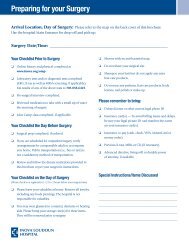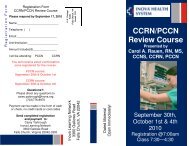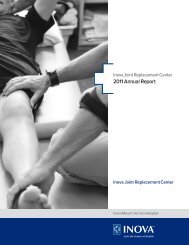Fairfax Hospital Neuroscience Services - Inova Health System
Fairfax Hospital Neuroscience Services - Inova Health System
Fairfax Hospital Neuroscience Services - Inova Health System
You also want an ePaper? Increase the reach of your titles
YUMPU automatically turns print PDFs into web optimized ePapers that Google loves.
Nutrition After a Stroke<br />
Everyone who has had a stroke should ask their doctor about an individual weight goal. If your<br />
doctor prescribes a heart healthy diet, the following information is provided as a guide.<br />
Heart <strong>Health</strong>y Diet<br />
May help lower cholesterol levels<br />
Can reduce plaque build-up in the arteries<br />
May help keep high blood pressure under control<br />
Can help you lose weight<br />
What to Eat<br />
Remember to include:<br />
Vegetables<br />
Fruit<br />
Whole grains<br />
Low fat dairy products<br />
Legumes<br />
Lean protein sources<br />
The key is to eat a variety of healthy foods and increase the fiber in your diet. Aim for 25g of<br />
fiber per day. As you adjust your fiber intake, remember to drink plenty of fluids to prevent<br />
constipation. Also, fish is a good source of lean protein and omega-3 fatty acids. Try to eat fish<br />
two times per week.<br />
Try to eat fewer foods with:<br />
Cholesterol<br />
Saturated fat<br />
Trans fat<br />
Salt<br />
Added sugar<br />
Substitute unsaturated fat for saturated fat. Aim for foods with little or no saturated or trans fat.<br />
Limit sodium to less than 2300 mg sodium or the level set by your doctor. The New 2010<br />
Dietary Guidelines for Americans recommends reducing sodium intake to 1500mg among<br />
persons who are 51 and older and those of any age who are African American or have<br />
hypertension, diabetes, or chronic kidney disease.<br />
Reading Food Labels<br />
When reading food labels, or the “Nutrition Facts” area, remember to look for:<br />
Serving size – this is the amount of food in one serving. Look at this closely because it<br />
may not be the amount in the container.<br />
Calories – the total calories in one serving<br />
Total fat<br />
Saturated fat and trans fat<br />
Sodium<br />
Dietary fiber<br />
PATIENT INFORMATION GUIDE FOR STROKE<br />
inova.org/neuro
















